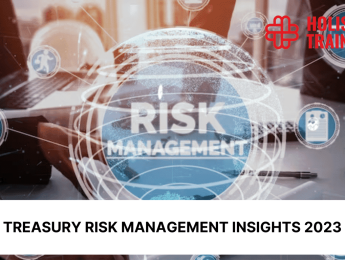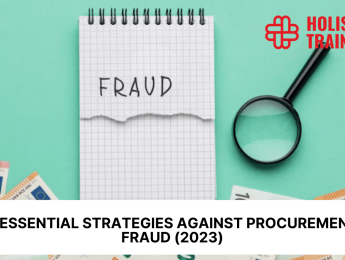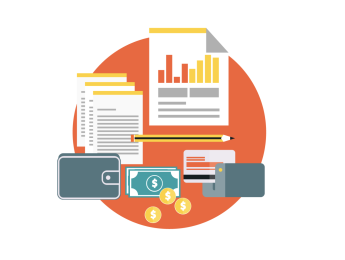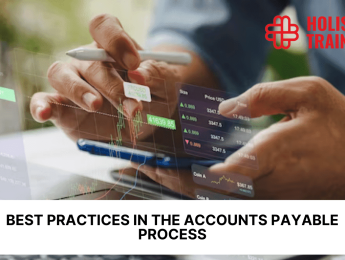In the complex and ever-fluctuating world of finance, where fortunes are made and lost in the blink of an eye, the importance of prudent risk management cannot be overstated. At the heart of an organization's financial stability and prosperity lies treasury risk management, an often-underappreciated discipline that plays a pivotal role in mitigating financial risks and optimizing returns. In this comprehensive exploration, we will delve deep into the realm of treasury risk management, unraveling its intricacies, tracing its evolution, understanding its significance, and exploring best practices.
What Is Treasury Risk Management
Treasury risk management is the strategic process of identifying, assessing, and mitigating financial risks that an organization encounters in the course of its operations. It's a multifaceted discipline that involves the careful orchestration of various risk management techniques to optimize the balance between risk and reward.
At its core, treasury risk management is about safeguarding an organization's financial assets and ensuring that it can meet its obligations, both short-term and long-term, in the face of a wide array of risks. These risks span the gamut from foreign exchange fluctuations and interest rate swings to credit defaults and operational hiccups.
To gain a comprehensive understanding, let's delve deeper into the key facets of treasury risk management.
Treasury Risk Management: Then vs. Now
The landscape of treasury risk management has transformed significantly over time, adapting to the evolving complexities of the global financial ecosystem. Let's contrast the traditional practices of treasury risk management with its contemporary counterpart.
In the past, treasury risk management was predominantly concerned with basic financial functions such as cash management and liquidity. These aspects were crucial but often approached reactively. Companies aimed to ensure they had enough cash on hand to meet day-to-day financial obligations, reacting to liquidity crunches as they occurred. The tools and technology available for risk assessment and management were limited.
In today's world, treasury risk management has expanded its purview far beyond mere liquidity management. It encompasses a broader spectrum of financial risks, making it a proactive and dynamic discipline. Advances in technology have empowered treasurers with sophisticated risk management software and analytics, allowing them to assess and manage risks in real time. This shift has positioned treasury risk management as a strategic function within organizations, rather than a reactive necessity. In addition to that, the Treasury and Risk Management Application Market is expected to experience robust growth, with a projected compound annual growth rate (CAGR) of 8%, resulting in the generation of approximately US$ 7.1 billion in revenue by the year 2028, according to
Future Market Insights.
[Enhancing financial stability blog post]
Examples of Risk Management Activities
Foreign Exchange Risk
Foreign exchange risk is one of the most prevalent risks faced by organizations engaged in international business. It arises from the unpredictable fluctuations in currency exchange rates. As companies buy and sell goods or services in foreign currencies, they can experience gains or losses due to currency movements. For instance, a US-based company selling products in Europe might see its revenues reduced when the euro weakens against the US dollar.
To manage foreign exchange risk, treasury departments often employ hedging strategies using financial derivatives like forward contracts or currency options. These tools allow companies to lock in exchange rates and protect themselves from adverse currency movements.
Interest Rate Risk
Interest rate risk is another critical concern for organizations, particularly those with significant debt or investments. This risk pertains to the potential impact of changes in interest rates on a company's cash flow, profitability, and the value of its assets and liabilities. Companies exposed to interest rate fluctuations may face challenges in managing their borrowing costs, attracting investors, or valuing their investment portfolios.
To mitigate interest rate risk, companies may use interest rate swaps, options, or futures contracts. These financial instruments allow them to hedge against adverse interest rate movements or even speculate on future rate changes.
Commodity Risk
Companies involved in industries like agriculture, energy, or manufacturing are exposed to commodity risk. This risk arises from the volatile prices of raw materials, such as oil, wheat, or metals, which can impact production costs and profit margins. For example, a food processing company might suffer reduced profits if the price of wheat, a key ingredient in their products, skyrockets.
Effective commodity risk management involves using derivatives like futures contracts or options to hedge against adverse price movements. By locking in prices for key inputs, companies can stabilize their costs and protect their profitability.
Credit Risk
Credit risk is the danger of financial loss resulting from the default or non-payment of a counterparty, whether it's a customer, supplier, or financial institution. While it's a common risk in business transactions,
credit risk management is crucial to prevent substantial financial losses.
To manage credit risk, treasury professionals employ a range of techniques. These may include conducting thorough credit assessments of counterparties, establishing credit limits, monitoring payment behaviors, and implementing credit insurance where appropriate. By carefully evaluating and mitigating credit risk, organizations can minimize the impact of defaults on their financial health.
Liquidity Risk
Liquidity risk is the risk of not being able to meet short-term financial obligations due to a lack of available cash or easily convertible assets. It's a particularly critical concern for organizations, as insufficient liquidity can lead to financial distress and even bankruptcy.
Treasury departments are tasked with ensuring sufficient liquidity to cover day-to-day operational needs and unforeseen contingencies. This involves maintaining adequate cash reserves, establishing lines of credit, and optimizing cash conversion cycles. Effective liquidity risk management ensures that organizations can weather financial storms and take advantage of strategic opportunities as they arise.
Operational Risk
Operational risk encompasses a wide range of risks stemming from internal processes, systems, and human error. Unlike some other risks, operational risks are not always financial in nature. They can affect an organization's reputation, compliance, and operational efficiency.
To mitigate operational risk, treasury professionals implement robust internal controls, automation solutions, and disaster recovery plans. These measures help prevent errors, detect irregularities, and ensure the continuity of critical financial processes. By addressing operational risks, organizations can safeguard their operations and maintain stakeholder confidence.
Risk Managers: Their Role & Top Qualities
Effective treasury risk management requires skilled professionals who understand the intricacies of financial markets, have a keen eye for detail, and can navigate complex scenarios. Let's explore the role of risk managers in treasury and the qualities that make them successful in their endeavors.
Role of Risk Managers
Treasury risk managers play a multifaceted role within organizations. They are responsible for:
Identifying Potential Risks
Risk managers must proactively identify potential risks that could impact the organization. This involves analyzing financial data, market conditions, and external factors that may pose risks.
Assessing Risk Impact
Once risks are identified, risk managers assess their potential impact on the organization's financial health and strategic objectives. This assessment informs decision-making.
Designing Risk Mitigation Strategies
Risk managers develop and implement strategies to mitigate or transfer risks. These strategies can vary widely depending on the type and severity of the risk. For instance, they may involve hedging, diversification, or insurance.
Monitoring and Reporting
Continuous monitoring of risk exposures is a key responsibility. Risk managers track risk metrics, assess the effectiveness of risk mitigation strategies, and report their findings to senior management and stakeholders.
Review and Adaptation
Given the dynamic nature of financial markets, risk managers must regularly review risk management strategies and adapt them to changing conditions. This ensures that the organization remains resilient in the face of evolving risks.
Top Qualities of Effective Risk Managers
Analytical Skills
Effective risk managers possess strong analytical abilities that enable them to dissect complex financial data, identify patterns, and assess potential risks. They go beyond the surface to conduct in-depth analysis, helping them anticipate and understand various risk scenarios.
Decision-Making Abilities
The ability to make informed and timely decisions is a hallmark of an effective risk manager. They must navigate rapidly changing market conditions, sometimes making crucial choices in high-pressure situations. Effective risk managers draw from their analytical insights to make decisions that align with the organization's risk tolerance and strategic goals.
Communication Skills
Clear and concise communication is vital for risk managers as they need to convey complex risk concepts and mitigation strategies to various stakeholders, including executives, board members, and team members. Effective communication ensures that everyone understands the risks and the actions required to manage them.
Adaptability
Financial markets and risk landscapes are constantly evolving. Effective risk managers exhibit adaptability by staying attuned to emerging risks, regulatory changes, and new technologies. They adjust their strategies and approaches accordingly to address evolving challenges.
Ethical Integrity
Maintaining high ethical standards is paramount for risk managers. Ethical integrity is not just a moral imperative but also a crucial aspect of risk management. It ensures that risk management practices are conducted transparently, ethically, and in alignment with legal and regulatory requirements.
Financial Market Expertise
A deep understanding of financial markets, instruments, and economic trends is indispensable for effective risk management. Risk managers need to interpret how global events and market dynamics can impact the organization's risk profile, making expertise in this area invaluable.
Cross-Functional Collaboration
Risk managers must collaborate effectively with colleagues from different departments, such as finance and operations. Effective risk management often requires input and expertise from multiple areas, and collaboration ensures a holistic approach to risk assessment and mitigation.
Why Is Treasury Risk Management Important?
While the intricacies of treasury risk management may not always be in the spotlight, its significance cannot be overstated. According to a
2022 report by Deloitte, organizations are now swiftly implementing strategies to tackle challenges related to liquidity management, financial risk, business continuity, and operational model enhancements. That being said, it’s important to delve deeper into why treasury risk management is becoming so indispensable for organizations:
Safeguards Capital
One of the primary objectives of treasury risk management is capital preservation. By identifying and mitigating financial risks, organizations protect their capital from erosion due to unexpected market fluctuations or adverse events. This preservation of capital is essential for sustaining operations, making strategic investments, and pursuing growth opportunities.
Enhances Decision-Making
Comprehensive risk analysis is not just about risk mitigation; it's also a powerful tool for informed decision-making. Organizations armed with a deep understanding of their risk exposures are better equipped to make strategic choices that align with their risk tolerance and financial objectives. This, in turn, contributes to more successful and sustainable business strategies.
Regulatory Compliance
In today's highly regulated financial environment, compliance with financial regulations and reporting requirements is non-negotiable. Treasury risk management ensures that organizations adhere to these regulations, reducing the risk of legal repercussions, fines, or damage to reputation. Compliance is not only a matter of legality but also a means to instill confidence in stakeholders.
Stakeholder Confidence
Investors, lenders, and other stakeholders place a premium on the financial stability and transparency of the organizations they engage with. A well-managed treasury function inspires confidence among these stakeholders. It signals that the organization is committed to responsible financial management and is proactive in safeguarding its interests.
Competitive Advantage
Sound risk management can be a source of competitive advantage. It allows organizations to operate more efficiently, price products or services more competitively, and take calculated risks when pursuing growth opportunities. In a marketplace where risk is inherent, those who manage it effectively can gain an edge over their competitors.
Treasury Risk Management Process
Effectively managing treasury risk involves following a structured process. This process is designed to systematically identify, analyze, and manage risks. Let's break down the key stages of the treasury risk management process:
Risk Identification
The first step in the process is to identify all potential risks that the organization may face. These risks can stem from internal and external sources. Internally, they may arise from operational processes, supply chain vulnerabilities, or financial strategies. Externally, they may be influenced by market conditions, economic factors, or geopolitical events.
During this stage, treasury professionals collaborate with other departments and stakeholders to ensure a comprehensive assessment of risks. Risk identification can involve scenario planning, historical data analysis, and industry research.
Risk Assessment
Once risks are identified, they need to be quantified and qualified. Risk assessment involves evaluating the potential impact of each risk on the organization. This assessment considers factors such as the probability of occurrence, the severity of impact, and the organization's risk tolerance.
For example, if a company is exposed to foreign exchange risk due to its international operations, the assessment may involve estimating the potential financial losses or gains from currency fluctuations. These assessments help prioritize risks based on their significance to the organization.
Risk Mitigation
Having identified and assessed risks, the next step is to design and implement risk mitigation strategies. The choice of strategy depends on the nature of the risk and the organization's risk appetite.
For instance, to mitigate foreign exchange risk, a company might choose to use financial derivatives like forward contracts or currency options to hedge against adverse currency movements. Alternatively, it may decide to diversify its operations across multiple markets to reduce its exposure to a single currency.
Risk mitigation strategies are designed to reduce the likelihood and impact of risks, ensuring that the organization is better prepared to weather adverse events.
Monitoring and Reporting
Effective treasury risk management is an ongoing process. After risk mitigation strategies are implemented, treasury professionals must continuously monitor risk exposures and the performance of risk mitigation measures.
This stage involves tracking key risk metrics, such as currency exposure, interest rate sensitivity, or credit limits. Regular monitoring allows organizations to stay ahead of potential risks and take corrective actions when necessary.
Additionally, treasury risk managers are responsible for reporting on risk management effectiveness to senior management, the board of directors, and other stakeholders. Transparent reporting ensures that decision-makers are informed about the organization's risk profile and the effectiveness of risk mitigation strategies.
Review and Adaptation
The final stage of the treasury risk management process involves periodic reviews and adaptations. Given the dynamic nature of financial markets and the ever-changing risk landscape, it's essential to revisit risk management strategies regularly.
During these reviews, treasury professionals assess the effectiveness of existing risk mitigation measures and adjust them as needed. They also consider whether new risks have emerged or if changes in the organization's operations or market conditions require adjustments to the risk management framework.
By continuously reviewing and adapting their risk management strategies, organizations can maintain resilience in the face of evolving risks and uncertainties.
Best Practices for Treasury Risk Management
Effectively managing treasury risk requires the implementation of best practices that align with an organization's goals and risk tolerance. These best practices encompass a wide range of strategic and tactical approaches. Here, we outline some of the most critical practices for treasury risk management:
Establish Clear Policies
Develop comprehensive risk management policies and procedures that outline the organization's risk tolerance, risk assessment methodologies, and risk mitigation strategies. These policies should be communicated throughout the organization to ensure consistent adherence.
Use Advanced Technology
Leverage cutting-edge risk management software and analytics for real-time data analysis. Advanced technology allows for more accurate risk assessment, faster decision-making, and the ability to respond to market changes promptly.
Diversify Risk Exposure
Avoid concentration risk by diversifying investments, customer bases, and business activities. Diversification helps spread risk across different assets or markets, reducing the impact of adverse events in one area.
Stress Testing
Conduct regular stress tests to assess the impact of extreme scenarios on the organization's financial health. Stress testing helps identify vulnerabilities and informs risk management strategies to mitigate them.
Cross-Functional Collaboration
Encourage collaboration between finance, treasury, and risk management teams. Effective risk management often requires input and expertise from multiple departments. Cross-functional collaboration ensures a holistic approach to risk assessment and mitigation.
Continuous Education
Invest in ongoing training and education for treasury staff to keep them updated on the latest risk management techniques and industry trends. Continuous education helps treasury professionals stay ahead of emerging risks and refine their risk management skills.
In the intricate world of global finance, treasury risk management stands as the compass that guides organizations through turbulent waters. From managing foreign exchange and interest rate risks to safeguarding against credit and operational hazards, effective risk management is indispensable for financial stability and growth.
Treasury risk managers, armed with analytical prowess and ethical integrity, play a pivotal role in securing an organization's financial future. By embracing best practices and adapting to changing market conditions, companies can navigate the intricate world of treasury risk management with confidence and resilience, ensuring their long-term prosperity in an unpredictable world.
Treasury risk management is not merely a corporate obligation; it is the cornerstone of financial prudence, a guardian of capital, and an enabler of strategic decision-making. As the financial landscape continues to evolve, organizations that prioritise and excel in treasury risk management will not only survive but thrive in the face of uncertainty.
For those eager to delve even deeper into the art of treasury risk management and become proficient in navigating financial waters, you need to explore our comprehensive course, ‘Treasury and Cash Flow Risk Management,’ where you can gain invaluable insights and practical skills to excel in this critical discipline. Secure your financial future by enrolling today!
Frequently Asked Questions (FAQ)
Treasury risk management is a comprehensive approach to identifying, assessing, and mitigating financial risks within an organisation. These risks can encompass a wide range of factors, including fluctuations in currency exchange rates, interest rates, commodity prices, credit defaults, and operational challenges. The primary goal of treasury risk management is to safeguard the financial health of the organisation and ensure its ability to meet its obligations, both short-term and long-term. It's not about eliminating risk entirely, which is often impractical, but about managing it effectively to optimise the balance between risk and reward.
Treasury risk management has evolved in response to the changing landscape of global finance. In the past, it primarily focused on basic functions like cash management and liquidity. However, as financial markets expanded and became more complex, organisations realised the need for a more proactive and holistic approach to risk management. This shift was facilitated by advances in technology, which provided treasury professionals with tools for real-time data analysis and risk assessment. Additionally, the scope of treasury risk management expanded to encompass a broader range of risks beyond liquidity, such as foreign exchange, interest rates, and operational risks, reflecting the multifaceted nature of today's financial environment.
Foreign exchange risk arises from the volatility of currency exchange rates, which can impact a company's financial performance when it engages in international transactions. To mitigate this risk, companies employ various strategies. One common approach is to use financial derivatives, such as forward contracts or currency options. These instruments allow organisations to lock in exchange rates at a predetermined level, effectively hedging against adverse currency movements. Additionally, some companies may strategically match their currency exposures with their revenues or expenses in the same currency, reducing their overall risk.
Effective risk managers possess essential qualities such as analytical skills for data analysis, strong decision-making abilities, clear communication skills, adaptability to changing market conditions, and a commitment to ethical integrity. These qualities collectively enable them to excel in managing complex financial risks, fostering a culture of risk-awareness, and facilitating effective communication across departments.
Continuous education is crucial for treasury professionals because it keeps them updated on evolving risk management techniques, industry trends, and regulatory changes. This ongoing learning allows them to adapt to new challenges, identify emerging risks, refine their skills, and ultimately enhances their ability to protect their organisations against financial risks, ensuring they remain resilient and competitive in the dynamic financial landscape.
























